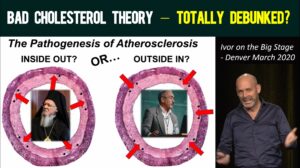FULL EPISODE NOW RELEASED: https://thefatemperor.com/dr-paul-mason-advanced-cholesterol-and-much-much-more-full-podcast-ep26/
Part 2 of 5 – Excellent conversation with super well-researched Australian doctor Paul Mason @DrPaulMason – recorded in Boulder, Colorado. We covered so much!
Full podcast released at the weekend – for those who want to pig out on excellent insights, all in one go 🙂
SUBSCRIBE here for latest releases: https://www.youtube.com/channel/UCPn4FsiQP15nudug9FDhluA
Here is the summary of PART 2 content – scroll down for the Transcript:
INDEX/CONTENT PART 2 of 5:
00:00:50 Glycation, Antioxidants – Carnitine and Carnosine Distinction
00:04:27 The body’s master antioxidant – Glutathione – and the Importance of GGT (Gamma Glutamyl Transferase)
00:08:08 Medical school training in nutrition – sadly lacking for doctors?
00:10:23 LDL-P, ApoB100, LDL Receptor activity – the bottom lines
TRANSCRIPT for PART 2 of 5:
Ivor 00:14:20 And you know, an irony, God, the irony is going to fly here. The irony is [name removed] went to a low carb diet because he was scanned to a fatty liver and his gamma glutamyl transferase was up over 100. And I told him, that’s fatty liver, right, “That’s diabetes.” He went on a low carb diet for just four to six weeks, collapsed all of his bad markers, GGT and I think ferritin, and everything looked fantastic. The doctor got a shock, but it’s bilirubin that’ve gone up significantly.
Paul 00:14:50 Yeah. If you’re under less oxidant stress, then you might not be depleting it as much. Obviously, there’s other pathways involved in bilirubin circulation.
Ivor 00:15:00 Yeah, but I guess it seemed to be when it goes up it’s a bad thing.
Paul 00:15:03 It’s a little bit like uric acid. I mean we always associate uric acid as being deleterious because it’s associated with gout, etc. etc. But uric acid is also an antioxidant. I’ll tell you some other ones is, melatonin is a powerful antioxidant and there’s nice evidence there that actually can reduce damage.
Ivor 00:15:24 Now, absolutely, I’ve heard of that. Now, with good sleep cycles and all, you probably optimize your melatonin compared to shift working and all the other negative effects of bad sleep. But, all of the antioxidants you’re talking about now they’re endogenous, internal made by our body antioxidants which can be very powerful. I think though the external antioxidants, that industry portion, nutraceutical I think they have very limited effectiveness compared to endogenous. What do you think?
Paul 00:15:52 I think I have to agree. But I would probably extend something a little bit further. So rather than talking about antioxidant, we will talk about antiglycation. And there is a substance. I don’t know if you have heard carnosine. Now, that’s kind of sine with an “s” – not carnitine. Everybody confused it to. That’s actually been shown to be a glycation inhibitor and it can actually reverse glycation as well. And it’s been shown to lower HbA1c in type 1 diabetics, and it’s also been shown to reduce kidney damage. It has all of these benefits, the downstream benefits is by interfering with the glycation on LDL particles, and it has been shown to interfere with glycation of LDL particles, then you prevent the downstream effects of the oxidation and the subsequent damage.
Ivor 00:16:39 Wow, the whole cascade, you caught it off at the knees so what?
Paul 00:16:42 And I guess that is an exogenous supplement, which I occasionally, if I’ve got a patient who I consider particularly high risk and I see a hell of a lot of glycation oxidation when I have a look at their lipid profile, then I often do recommend substances to inhibit glycation and to inhibit oxidation while they’re in a high risk phase.
Ivor 00:17:04 Excellent. And you know what, it immediately rang a bell there because several months ago I met a couple from England who they’re promoting an Eastern European developed scanner. I think it connects to your ankle and elsewhere. But they were saying that exactly that the carnosine in high doses, higher than the recommended doses has a dramatic antioxidant effect. And I was meeting with them quite briefly. And I thought afterwards, “Did they mean carnitine?” But I said, “No, they did say “carnosine” and I intended looking it up but I never got a chance.
Paul 00:17:38 Yeah. Well, it’s two amino acids complex together. It’s pretty simple substance.
Ivor 00:17:42 Oh, yeah. But carnitine is the one that always brings to mind than carnitine shuttle and all that stuff.
Paul 00:17:47 Well carnitine is actually… I mean, I’m a sports medicine physician, so what gets me out of bed in the morning is you know, training athletes and trying to optimize their performance. And we’re actually mocking around a little bit at the moment seeing if we can just eat a little bit of extra fat metabolism out in some of our elite athletes by using carnitine.
Ivor 00:18:07 Oh, carnitine.
Paul 00:18:08 Carnitine, yeah. Because I mean, once you get up to about the two grams a minute, you basically top out of your fatty acid oxidation. So we’re just trying to obviously, if we can enhance that, then you can run along at a higher VO2 for a little bit longer.
Ivor 00:18:23 Excellent. Well, that sounds like really interesting work.
Paul 00:18:25 That’s a bit of a digression.
Ivor 00:18:27 Well, it’s inherently safe as well. But carnitine, to something else but carnitine… oh, it escapes me now, it’ll come back to me later. So carnosine is the supplement. Then there’s glutathione, the body’s primary antioxidant.
Paul 00:18:42 Yeah, yeah.
Ivor 00:18:43 That’s pretty central, right? That’s kind of the central processor of…
Paul 00:18:47 Yeah, well, this is an antioxidant. And I mean, this just leads to so much. It’s involved. Vitamin C is involved in the production of glutathione fine as well. And funnily enough, there’s a strong relationship between need for vitamin C and your oxidant state, possibly due to the need to generate more glutathione.
00:19:09 We could divert here and talk about a condition called favism, or intolerance of broad beans. It is a genetic condition where people have broad beans and they have so much oxidants stress, they deplete all the glutathione and essentially, they destroy their red blood cells.
Ivor 00:19:27 Wow…
Paul 00:19:27 so I mean you can see what happens if you don’t have enough glutathione. And it’s not that it’s a deficient state of glutathione, it’s just that it just ran out.
Ivor 00:19:36 It’s essentially running out, and then all the reason I got into biochemical research and all this six years ago was I had a very elevated gamma glutamyl transferase. And that of course creates glutathione and it can also break down glutathione. So if you’ve a high GGT, it’s a screaming indicator that you are depleting or overly needing like glutathione and deliver damage that often ties into many of these issues. So there are a lot of these measurements and things that people aren’t really aware of because there’s too much talk on cholesterol.
Paul 00:20:08 I mean, we could spend an hour just talking about the different liver enzymes. I mean, they all have different functions, they all mean different things.
Ivor 00:20:14 And they’re all really important, but they’re undervalued.
Paul 00:20:16 Yeah, well, if you understand what the different patents mean, I mean, it’s really valuable information. And it depends on the patient too. So if somebody comes in and they like to have a bit of a tipple, that’s significant because GGT is an enzyme. It’s what we call inducible. That means that if you’re having a lot of alcohol, the amount of GGT will actually increase as a part of the body’s need to process that alcohol. Whereas at some of the other liver enzymes, if we have a look at AST and ALT, then they’re actually contained within hepatocytes and they get released into the circulation when the hepatocytes dies. Think of it bursting open and the chemicals released into the blood. So a lot of the enzymes, that we actually test for, we actually were looking for an increase and we infer that if they present in the circulation at a higher level than they ought be, then the cell that was originally containing that has died.
Ivor 00:21:13 So cellular damage increases in the liver and you get these elevated liver enzymes essentially.
Paul 00:21:18 Yeah, yeah.
Ivor 00:21:19 And it’s very important. Yeah, GGT was classically used for a long time to find alcoholics or check whether they were back on the wagon.
Paul 00:21:27 I still use it as a flag.
Ivor 00:21:28 Yeah. The irony is though, even with no alcohol XXXXX for instance, practically doesn’t drink. He was over 100 in his GGT, and it was his fatty liver so it’s…
Paul 00:21:37 … oxidant stress though. And when he took away the oxidant stress, his bile went up. Funnily enough…!
Ivor 00:21:41 Absolutely!
Paul 00:21:42 Because less need to use the antioxidant capacity of the bile.
Ivor 00:21:47 Exactly. And he was eating a lot, and actually watching movies and television, he was eating a lot of ice creams and he was eating a lot of chocolate and he was a devil as we say, a devil for fruit juice. He drank a ton of fruit juice and he thought it was healthy. He thought it was five a day. This misinformation is out there on so many foods.
Paul 00:22:08 Ah, it’s amazing. The funny thing is, even doctors, just because we go to med school, it doesn’t mean we not talk about any of this. We literally don’t. We have no training in us.
Ivor 00:22:26 No, but your personal research to the databases, the publications and your patients. you’ve generated an enormous amount of knowledge in fairness. But as you say, how much of that really came from medical school? It sounds like.
Paul 00:22:40 Well, I’m actually look, I’ve just finished the fellowship a year and a bit ago. That’s a four-year specialization on top of when you finish your earlier training. And that’s one of the only two specialties in Australia that has a formal nutrition component. And I can tell you without a shadow of doubt that what I learned was out of box. I’m currently in conversation with the seniority within the college to actually rewrite some of their curriculum, which was for a specialist medical college. To be honest, I’m not holding my breath, but if we could have a low carb friendly medical curriculum within a specialist medical college, I mean, that’ll be a real feather in the cap.
Ivor 00:23:26 Wow, it would. Congratulations! That’s a huge movement. But what you’re saying is bollocks. I mean, they’re essentially giving out the same old food pyramid style nutritional belief system, which is less than worthless.
Paul 00:23:40 Yeah. Look, there is some movement towards where the evidence is, but it’s sort of like, you know, two steps forward one step back and being dragged along, kicking and screaming. There’s certainly not a wholesale embrace of the literature. And I’ve been… it was just actually last week, I had a few more emails, it’s inviting me to review the curriculum for them. And I guess I’m sort of testing the waters a little bit and saying, “Well, how keen are you to actually…” because you know what I’m going to say. Is there the political will there to actually change things if they do need to be changed? And that I’m not so sure about.
Ivor 00:24:23 We’ll see what happens. Well, anyway, this is always going to be challenging, but it’s great to see some movements within it. So why don’t we jump to now, just to be a real jumper around it. LDL-P maybe, the particle. That’s very topical.
Paul 00:24:35 Well, that’s topical and I think it’s as the conclusion you’ll come to and we had a pre broadcast conversation, I think it’s absolutely correct. All it is if you understand you have the LDL particles in circulation, and they’re healthy, and when they’ve delivered all their cargo, dropped off their triglycerides where they need to be, then they go back to the liver. So you’ve got this receptor on the outside called ApoB100. And that binds to the LDL receptor in the liver. It’s a doorway, it’s like a security spot goes back into the liver, take it out of circulation.
00:25:10 Now the only thing that will stop it from leaving the circulation is if that ApoB100, that security SWAT card is damaged, and that can be damaged by glycation. And so essentially, if you damage it by glycation, your LDL particles will accumulate in the circulation. But they won’t be the big ones. Because, as you know, when you glycate an LDL particle, it actually changes the size just fractionally to the point of where it’s called small dense. So it’s a very slight kind of reduction. And as well as that, it’s the LDL that’s already delivered its cargo. So it already started out as a smallest of physiological LDL particle would be and then you might have a little bit smaller with glycation.
00:25:57 So if you actually were to take all of these LDL particles that are accumulating and building up and put them in a glass jar, they wouldn’t actually take up that much volume because they’re all small. So that’s why the LDL particle count is actually a better marker than total volume of LDL, of LDL cholesterol.
Ivor 00:26:18 Yeah, just for people watching, the classic LDL measure was LDL-C where you smashed up all the particles per unit blood volume and found out how much cholesterol molecules are inside them. But the LDL-P as you say is counting the particles…
Paul 00:26:31 The particle number, not… yeah, so if you just get them on and smoosh them in a jar and said it takes up this much room, that’s the total volume of LDL. Nut that that’s not useful because the LDL particles might be really big. They might be carrying a lot of cargo, and they might be undamaged.
Ivor 00:26:48 And most crucially as that latter point , they may be on damaged or they may be damaged LDL. So if you have a guy who’s got a 2200 count, and another guy is a 2200 count, orthodox medicine I fear sometimes thinks, “Well, they’re both high score, they both have a high risk.” One guy has no damaged LDLs, and his glycocalyx and endothelium is all in great shape, blah, blah, blah. And his HDL is working fantastic, the efflux, any that get into the wall, right? The other guy beside him, everything could be in a mess. One guy is really high risk, one guy is not high risk. But if you just look at the number, you don’t know.
Paul 00:27:26 Yeah, that’s true. That’s true. I mean, I’ve really like… I do a couple of tests. I do a liquid subfraction, where we basically fractionate it. It’s pretty simple. You put the substance in a gel and use centrifuge it through and it will travel down through the gel based on its density basically. You can do electrolysis, where it separates up based on charge, but I just like the density when the particles get separated out by size. In addition to that, I can do a special test for oxidized LDL using monoclonal antibodies that will bind to the antigen or the epitopes on oxidized LDL. So I combine those two tests and I also, you know, I’ve got the benefit, I can do ApoA1 which is found on HDL, I can do B100. And I can do LP(a). So, I’m so lucky, as a medical doctor, I can actually have a patient come in, and I can do a complete analysis. And I’ll be honest so, most of the time I have people seek me out. They know I’m relatively knowledgeable about cholesterol, and they say, “My GP wants to put me on a statin and I need you to reassure me. I need you to do all these testing on me.” Nine times out of 10 I say, “You can do the testing, it’ll cost you this much money, I don’t recommend it.” And the reason is because we can usually infer enough. That people that seek me out are usually on a healthy diet, they usually ketogenic they usually got a triglyceride that’s as low as you like, and a HDL that’s outside the normal range being high. We can run the metrics there and we can just play probabilities and we can say, “Oh my, certainly your profile is going to be okay.” A lot of people come in, they just say, “Look, I understand the theory, but I just want the comfort that I get from seeing a pretty colored graph,” you know or what have you and will often do that. But usually, I actually recommend people not to do it simply because that’d be better off spending that money on a massage.







